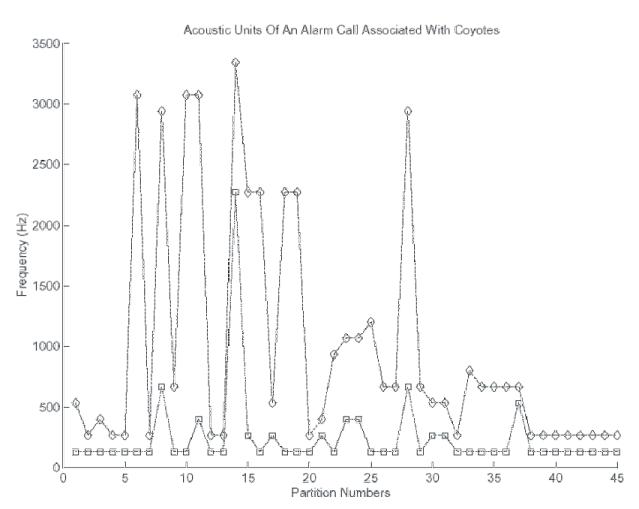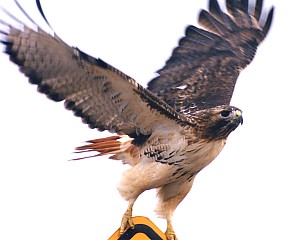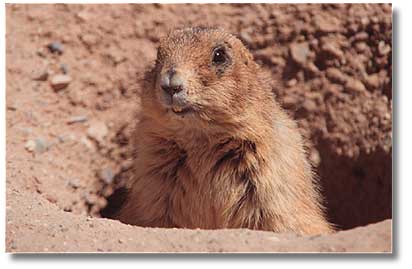Prairie Dog Language?
by Ronald P. Millett and John P. Pratt
Reprinted from Meridian Magazine (19 May 2005).
©2005 by John P. Pratt. All rights Reserved.
Index,
Home
Prairie dogs use a sophisticated vocabulary in their warning barks, which again
raises the question of whether mankind alone communicates by audible language.
The ability to formulate and use language has long been considered to be a key differentiating
characteristic that distinguishes man from animals. Although that argument has been used by
creationists to counter evolutionary theories, the entire conjecture may be without scriptural
foundation. That is, the scriptures do not tell us that animals don't communicate, and there are indications that they might have sufficient intelligence to do so (Gen. 3:1, 7:9, Num. 22:28). Do animals really communicate to each other with the variety of sounds they can produce?
 |
Gunnison's Prairie Dog on guard.
As part of a twenty year study of prairie dogs, researchers led by Con Slobodchikoff, a Northern
Arizona University biology professor, have now been able to analyze linguistic characteristics of
their warning calls that appear to qualify as a limited language.[1] Prairie dogs have the ability to
use nouns and modifiers, and even coin new "words." Their barks clearly distinguish between
dogs and coyotes, and can include sounds for concepts such as size and color. Perhaps the most
mysterious aspect is that widely separated colonies immediately create identical new barks to
describe totally new concepts, such as a "black oval." Mankind cannot even do that, so how can
these observations be explained?
1. Is Language Unique to Man?
 |
Black-tailed Prairie Dog stretches to see predator.
As Christian writers have defended the Biblical view of the creation by intelligent design instead of
by evolution, the miracle of language that seems to distinguish humans from animals has been
considered to be a key argument. For example, they refer to "Language, that unique faculty
possessed by man alone."[2] And again, "One element, which is characteristic of and indispensable
to all human language is missing [from primates]; we find no signs which have an objective
reference or meaning."[3] As discoveries have been made of animals displaying some language-like behaviors, such as sign language that can be taught to chimpanzees and baboons, and other indications of language for dolphins, sea lions and parrots,[4] the anti-creationists gleefully claim that creationism is disproved and there is no need for an Intelligent Designer to fashion the universe. They believe that the laws of the universe, driven only by random chance and survival by natural selection, are sufficient to create all that is.
Latter-day saints, however, believe that although God did not make the animals "in His own
image, nor endow them with God-like reason and intelligence",[5] he did endow them with a degree
of divine intelligence and they will enjoy "eternal felicity" in the resurrection (D&C 77:3). We
authors would not be surprised if Balaam's donkey really were allowed to say "What have I done unto
thee, that thou hast smitten me these three times?" (Numbers 22:28). That sentence shows
complex elements of language use including questions and if-then logic. Perhaps Balaam was just allowed to read the animal's thoughts but that would serve the purpose just as well. Any language behavior by animals would seem to us to prove even more the divine design and creation of life. The recent articles proclaiming new discoveries in the linguistic abilities of prairie dogs show a fairly complex level of language use for these small creatures that are considered to be of minimal intelligence. That God would enable these so-called "simple" creatures to exhibit such complex behavior increases our appreciation of the miracle of language.
2. The Prairie Dog's Warning Barks
 |
Prairie Dog Sentinel.
At first, the short, repeated warning barks of the sentry prairie dogs as they see a potential predator
may seem very much alike, perhaps being general warning calls. These calls can be heard nearly a mile away. As Dr. Con Slobodchikoff began
to slow down the rapid barks and analyze them using electronic sonogram technology, he observed
important differences. The barks when a hawk approached the colony were different from the
barks when a coyote approached. To find out how far this language ability could go, the
researchers built blinds on the edge of the colony so they could tape record and videotape
the prairie dog barks and behavior in the context of different predators. They have been collecting
and analyzing data using various methods for many years. While earlier papers have reported
analysis using neural networks[6] and various averaged acoustic summary variables,[7] the latest
research has attempted to define linguistic symbols from the digitized barks to analyze and group
similar calls together.
 |
Figure 1. Sonogram of prairie dog bark for "dog," divided into 45 time segments. The two points for each segment indicate the two most dominant frequencies.
Figure 1 shows the sonogram for the warning bark for a dog predator approaching the colony as
reported in the journal Behavioural Processes in 2004.[8] The two dominant frequencies are plotted and the
short barks of about one tenth second duration are divided into 45 time segments. Frequency
corresponds to the "pitch" of the sound, that is, high frequency means high pitch. Each of those
45 parts is analyzed to create acoustic unit symbols based on the two frequencies, derived from
statistical studies of prairie dog calls over a period of over 10 years. In the journal article
describing the computational process of recognition of basic classes of predators, 85 acoustic
symbols were identified. This string of 45 symbols is then matched against standardized
dictionary values for each prairie dog word. Even among different prairie dogs from a wide area
and over a period of ten years, new calls were able to be correctly analyzed up to 100% of the time
for many of the predators.[9] Those are amazing results for the low quality audio recordings, which often were taped over 100 yards away.
2.1 Nouns
Figure 2 shows the sonogram for one warning call for a coyote. Note how different the
frequencies are compared to the dog sonogram. Also notice the complex structure of alternating
high and low pitch, with the entire "word" only taking about a tenth of a second.
 |
Figure 2. Sonogram of one prairie dog bark for "coyote." Note the very steady low frequency combined with the quick large variations in the high frequency.
 |
The coyote, principal prairie dog predator.
These two examples should be enough to convince us that indeed there are significant differences
between the barks for dogs and coyotes. Slobodchikoff and his other researchers used this
methodology to try to understand more prairie dog words.
After recognizing different bark names for predators such as red-tailed hawks, coyotes, dogs,
skunks and badgers, other words were also found for non-predators such as deer, elk, antelope
and cows. Clearly the prairie dog vocabulary includes a variety of nouns as names of various
types of animals.
2.2 Adjectives
 |
Prairie dogs fear the red-tailed hawk.
Then another amazing language characteristic emerged: the ability to add modifiers to a basic noun
category. The prairie dogs have different words for attributes such as color, size, and speed of
travel. There were different words for different kinds of dogs, for a man with a yellow coat, and
even for a man with a yellow coat with a gun. When the man with the yellow coat and gun came
out the next day without the gun, he was still given the same bark from the day before when he had
a gun. The memory of the name for one specific person was retained for a period of two months.
The research has shown at least 20 different basic prairie dog words describing predators, with
many more variations to account for modifiers, totaling about 100 words.[10] That does not mean
their vocabulary is limited to that number of words, but rather it indicates the current state of our
knowledge. It takes many experiments to verify each new word. The test environment of predators and the resulting sentry bark responses allow the researchers to actually understand the topic of conversation, a subject not easily controlled in scientific experiments. At this time we have no idea what prairie dogs might talk about over breakfast.
2.3 Coining New Words
 |
Prairie dogs barked a word for the European Ferret.
When something totally new such a European ferret was shown to isolated prairie dogs, each
immediately barked out a new warning word. What came as a complete surprise was that when the
new predator was shown to widely separated prairie dogs from different colonies, each barked the
same word to describe the never-before-seen ferret. Just how could they do that? As Alice in
Wonderland said, this is getting "curiouser and curiouser."
Later, to see just how far this unique coining ability extended, totally new test objects were shown
to the colonies. The researchers made plywood cutouts with silhouettes of a coyote, a skunk and
even a black oval.[11] As they pulled these silhouettes through the prairie dog town with a rope,
once again without hesitation the prairie dogs came up with new words for each, and again these
same words were used by all prairie dogs tested. The use of non-living objects as these seems to
weaken any explanation that the prairie dogs were discerning a universal spiritual name emitted by
the living predator itself. How could all prairie dogs instantly know the word for "black oval"?
 |
Prairie dogs have a word for badger.
This ability to coin new words is generally accepted as one of five essential linguistic features for a
set of words to qualify as a real language. "It must contain words with abstract meanings; possess
syntax in which the order of words is part of their meaning; have the ability to coin new words; be
composed of smaller elements; and use words separated in space and time from what they
represent."[12] Slobodchikoff argues that his research is making progress on all five of these fronts and hence the barks should qualify as a limited language.
The amazing aspect of the prairie dogs' coining of new words is that they
always came up with the same new word. This ability to coin identical new words between
separated groups does not occur in human languages. A new word for a new unfamiliar object is
not the same from one group of people to the next. But the prairie dog bark for "black oval" is the
same from one prairie dog to the next, even with one isolated from the other in remote colonies.
"'There are no black ovals running around out there and yet they all had the same word for black
oval,' Slobodchikoff said. He guesses the prairie dogs are genetically programmed with some
vocabulary and the ability to describe things."[13]
If he is correct, can you imagine the complexity of programming these words into the DNA of
these rodents? How many bits would be involved? How would this ability plus the new words
that might someday be needed (such as black oval) be programmed?
3. Artificial Intelligence
Having spent much of our careers tackling hard problems in the field of Artificial Intelligence such
as language translation, CAD/CAM expert systems, full text information retrieval, and Boeing 777
functional electrical analysis, we authors have a great respect for programming even the simplest of
the answers to these questions. To us it seems unimaginably difficult to have words to describe all
possible objects pre-programmed into a rodent, for the following reasons.
3.1 The SHRDLU Program
Terry Winograd, a professor of computer science at Stanford University created an imaginary
world of cones, pyramids, and blocks of different sizes and colors.[14] In this small context, the
SHRDLU program (derived from the keyboard of the linotype typesetting machine) could respond
to commands shown in Figure 3 resulting in a graphical display of the state of its world shown in
Figure 4.
Person: PICK UP A BIG RED BLOCK.
Computer: OK.
Person: GRASP THE PYRAMID.
Computer: I DON'T UNDERSTAND WHICH PYRAMID YOU MEAN.
Person (changing their mind): FIND A BLOCK WHICH IS TALLER THAN THE ONE
YOU ARE HOLDING AND PUT IT INTO THE BOX.
Computer: BY "IT", I ASSUME YOU MEAN THE BLOCK WHICH IS TALLER THAN
THE ONE I AM HOLDING.
Computer: OK.
Person: WHAT DOES THE BOX CONTAIN?
Computer: THE BLUE PYRAMID AND THE BLUE BLOCK. |
Figure 3. SHRDLU program developed in 1970 by Terry Winograd interactions showing interactive language analysis, semantic understanding and language synthesis for its small basic shape world.
 |
Figure 4. Graphical representation of the SHRDLU world.
The programming of this system is surprisingly complex.[15] The programming language has to first
be defined and running on some computer software and hardware system, which in turn is
dependent on electricity and other basic services. Then, based on this foundation, software
developers can spend years of time to create, implement and debug programming modules,
submodules, and complex data structures to represent the small SHRDLU world. All this for a
relatively "simple" language ability! In 2004, Terry Winograd himself evaluated the state of AI
systems today as follows: "There are fundamental gulfs between the way that SHRDLU and its
kin operate, and whatever it is that goes on in our brains. I don't think that current research has
made much progress in crossing that gulf, and the relevant science may take decades or more to get
to the point where the initial ambitions become realistic."[16]
If we are amazed at the complexity of chromosomes being able to correctly repair copying errors in
themselves, then what about a starter basic language ability that is fantastically more difficult to
program? How would one go about "evolving" a language ability written directly in the DNA code
of every cell by the creature itself?
3.2 Incredibly more complex
If we go from the relatively small worlds of the prairie dog's warning system or the SHRDLU
world of simple objects, once again the difficulty skyrockets. Over the years, I (R.P.M.) have
often had a difficult time watching science fiction shows such as "Star Trek." These shows would
often demonstrate a feat of artificial intelligence close to what is possible today, such as saving a
session under Kirk's voice print, followed immediately by another one, four quadrillion or so times
more difficult, but accomplished just as easily.
For example, in one Star Trek show, the script contains
this interaction with the Enterprise's computer:
- Kirk: Computer.
- Computer: Ready.
- Kirk: This is the captain. Record security research, to be classified under my voice print
or Mr. Scott's.
- Computer: Recorded.
- Kirk: Produce all data relevant to the recent ion storm. Correlate following hypothesis:
Could a storm of such magnitude cause a power surge in the transporter circuits
creating a momentary interdimensional contact with a parallel universe?
Computer: Affirmative.
- Kirk: At such a moment, could persons in each universe, in the act of beaming, transpose
with their counterparts in the other universe?
- Computer: Affirmative.
- Kirk: Could conditions necessary to such an event be created artificially using the ship's
power?
- Computer: Affirmative.[17]
In our minds we almost effortlessly understand the questions in this exchange and we may have
some idea of how a scientific team might go about answering those questions. But for a computer
to really understand it in a general sense and in such a general context? That leaps a gulf so wide
that it would almost certainly take centuries to achieve.
 |
Do prairie dogs think?
The complex systems of language that we take for granted are dependent on logical and
programming capabilities that are themselves more complex than the tasks they implement. This is
why software programmers never look at a section of programming code and say: "I wonder how
this code sprang into being" or "Wow! This code must have evolved over millions of years by
chance." We always look at complex code and see an intelligence behind it. Something as
complex as the creation of life with its programmed capabilities certainly to us implies a Master
Programmer.
4. Believe in God
So how do the prairie dogs come up with the word for "black oval"? It would appear that they
either get it from outside of themselves or from within, and to us, none of the theories yet
proposed for either method has much chance of being correct. Our best theories are totally inadequate to explain these observations, and each new experiment seems to produce even more confounding results. The supposedly sophisticated linguists are "speechless" when it comes to explaining even the simplest syllables of a prairie dog.
We can only imagine the spiritual and intellectual dimensions of life that might be involved in the
prairie dogs' amazing linguistic gifts. Such speculations seem to us more likely than trying to
write all possible new words, or abstractions of them, into the DNA code itself just so that two
isolated prairie dogs can each immediately come up with the same word for "black oval."
To us authors, our best posture to explain these results is to simply believe the Book of Mormon
admonition:
Believe in God; believe that he is, and that he created all things, both in heaven and in earth; believe that he has all wisdom, and all power, both in heaven and in earth; believe that man
doth not comprehend all the things which the Lord can comprehend. (Mosiah 4:9)
5. Conclusion
This article has summarized groundbreaking research that reveals sophisticated language use by the
prairie dog. Their ability to coin new words has thus far defied reasonable explanation. To us it
indicates that a divine Creator was required to endow these rodents with this language gift. Surely, even a higher level of design and intelligence would be required to enable the incredibly more complex
linguistic abilities of mankind as spiritual children of the Living God.
Notes
- Tania Soussan, "Language of Prairie Dogs Includes Words for Humans," Associated Press, December 6, 2004,
www.livescience.com/animalworld/prairie_dogs_041206.html. See also Sadie Babits, "Decoding the Prairie Dog Language," August 29, 2003, KNAU radio, audio link at www.knauradio.org/News/News.cfm?ID=984&c=17. It is a radio interview with Slobodchikoff about his research. Prairie dog bark samples are also played on this interview. A detractor is also interviewed who sees the research as inconclusive. Here is a partial transcript by the authors:
Describing his method of data gathering with video and audio recorders,
Slobodchikoff says: "And so now we know what the prairie dog said when the
coyote was there. We know what the prairie dog did when the coyote was
there."
His ultimate goal: "Eventually, he hopes to prove that animals can
think."
Slobodchikoff : "This opens the door to showing that animals have far more
complex capability than we have given them credit for. What philosophers
have long said is that animals can't think because to think you have to
have language. And because animals don't have language, they can't
think."
"John Placer, the chair of computer science at NAU, has designed
interpretive software, essentially creating a modern day 'Rosetta Stone'
for unraveling prairie dog language."
Placer: "We have the tools and have developed the capability of the
computer software programs that can look at the details of the
vocalizations. We have just started that process in terms of the
vowel-like sounds and consonant-like sounds. But as we extend that work,
it looks like we might be able to mine a level of detail that no one had
really been aware of."
- Arthur Custance, Genesis and Early Man, (Grand Rapids, Mich.: Zondervan, 1975) abstract, online at custance.org/Library/Volume2/index.html.
- Ernst Cassirer, "An Essay on Man," Yale, 1948, pp. 28, 29, quoted in Custance, op. cit., p. 256:
" Everyone who examines the different psychological theses and theories with an unbiased and
critical mind must come at last to the conclusion that the problem cannot be cleared up by simply
referring to forms of animal communication and to certain animal accomplishments which are
gained by drill and training. All such accomplishments admit of the most contradictory
interpretations. Hence it is necessary, first of all, to find a correct logical starting point, one which
can lead us to natural and sound interpretation of the empirical facts. This starting point is the
definition of speech . . . . The first and most fundamental stratum is evidently the language of the
emotions. A great portion of all human utterance still belongs to this stratum. But there is a form of
speech that shows us quite a different type. Here the word is by no means a mere interjection; it is
not an involuntary expression of feeling, but a part of a sentence which has a definite syntactical
and logical structure. . . . As regards chimpanzees, Wolfgang Koehler states that they achieve a
considerable degree of expression by means of gesture. Rage, terror, despair, grief, pleading,
desire, playfulness, and pleasure are readily expressed in this manner. Nevertheless one
element, which is characteristic of and indispensable to all human language is missing; we find no
signs which have an objective reference or meaning. "It may be taken as positively proved,' says
Koehler, 'that their gamut of phonetics is entirely. subjective and can only express emotions, never
designate or describe objects. But they have so many phonetic elements which are also common to
human languages that their lack of articulate speech cannot be ascribed to secondary (glosso-labial)
limitations. Their gestures too, of face and body, like their expressions in sound, never designate
or describe objects.'"
- Several great articles are found in The Cognitive Animal, ed. Marc Bekoff, Colin Allen, and Gordon Burghardt (Cambridge, Mass.: MIT Press, 2002). See Herbert Roitblat, "The Cognitive Dolphin" (p. 183), R. Schusterman, C. Kastak, and D. Kastak, "The Cognitive Sea Lion" (p. 217), Irene Pepperberg, "Cognitive and Communicative Abilities of Grey Parrots" (p. 247), Louis Herman, "Exploring the Cognitive World of the Bottlenosed Dolphin" (p. 275), and Barbara Smuts, "Gestural Communication in Olive Baboons and Domestic Dogs" (p. 301). The relevant article on prairie dogs is C. N. Slobodchikoff, "Cognition and Communication in Prairie Dogs" (p. 257).
- Joseph F. Smith, Messages of the First Presidency, Vol 4:206:
"By His almighty power He [God] organized the earth, and all that it contains, from spirit and
element, which exist co-eternally with Himself. He formed every plant that grows, and every
animal that breathes, each after its own kind, spiritually and temporally. ... He made the tadpole
and the ape, the lion and the elephant, but He did not make them in His own image, nor endow
them with God-like reason and intelligence. Nevertheless, the whole animal creation will be
perfected and perpetuated in the hereafter, each class in its 'distinct order or sphere,' and will enjoy
'eternal felicity.' That fact has been made plain in this dispensation."
- J. Placer and C. N. Slobodchikoff, 2000. "A fuzzy-neural system for identification of species specific alarm calls of Gunnison's prairie dogs," Behavioural Processes 52:1-9:
"In this study we describe the design and application of an automated classification system that
utilizes artificial intelligence to corroborate the finding that Gunnison's prairie dogs have different
alarm calls for different species of predators. .... Previous study processed a smaller data set and
utilized manual measurement techniques. The new classification system, which combines fuzzy
logic and an artificial neural network, classified alarm calls correctly according to the eliciting
predator species, achieving accuracy levels ranging from 78.6 to 96.3% on raw field data digitized
with low quality audio equipment." (Abstract)
"The values show that the classification results are highly significant (x2=793, df=9, P<0.005)."
(Section 3) The values charted show a comparison of expected random barks vs. the experimental results.
- S. H. Ackers and C. N. Slobodchikoff, 1999. "Communication of stimulus size and shape in alarm calls of Gunnison's prairie dogs," Ethology, 105:149-162:
"A spectrogram of two prairie dog alarm barks produced in response to the coyote silhouette.
Eight points were digitized from the spectrograph screen and used to calculate the variables used in
the stepwise discriminant function analyses. The variables are abbreviated in the spectrogram as
follows: DHF: dominant harmonic frequency (Hz), FF: fundamental frequency (Hz), SHF:
supradominant frequency (Hz), IHI: interharmonic interval (Hz), DUR: duration (ms), SLOPEA:
ascending slope (Hz/ms), SLOPED: descending slope (Hz/ms)." From Figure 1 in article.
- J. Placer and C. N. Slobodchikoff, "A method for identifying sounds used in the classification of alarm calls," Behavioural Processes, Volume 67, Issue 1, 30 July 2004, Pages 87-98. Our figures 1 and 2 correspond to their figures 2 and 3.
- Ibid., abstract.
"Using a simple representation similar to that used in human speech to identify vowel sounds, a
software system was developed that uses this representation to recognize acoustic units in prairie
dog alarm calls. These acoustic units are then used to classify alarm calls and their associated bouts
according to the species of predator that was present when the alarm calls were vocalized.
Identification of bouts with up to 100% accuracy was obtained."
- C. Slobodchikoff, "Prairie Dog Communication," Prairie Dog Information web site, 2005, www.prairiedog.info/Prairie_Dog_Communication.htm.
" Slobodchikoff has documented more than 100 prairie dog words all revolving around the same
subject: predators. From his observation tower on the edge of a prairie dog colony outside
Flagstaff, Slobodchikoff operates a directional microphone, a tape recorder and a video camera.
From this vantage point, he can spot intruders, such as hawks, cats, dogs, and men and record the
alarm calls these potential threats trigger in the prairie dogs.
'Each time we do experiments I'm surprised because each time even I don't think these animals
have the capabilities that our experiments show them to have,' says Slobodchikoff.
Back at his lab he digitizes his audio field tape into sonograms which show what each alarm call
"looks" like, complete with adjectives. The professor has discovered that prairie dogs use
adjectives to differentiate objects. For example, they can describe the color of clothes on a human
and whether he is tall or short. They can also describe how fast a man is moving or whether he is
carrying a gun. And there's evidence that the animals can remember that specific person for up to
two months."
- Ackers, op. cit. describes the preparation of the silhouette models and the analysis of the response from the prairie dogs.
- Soussan, op. cit.
- Ibid.
"Slobodchikoff has also played back a recorded prairie dog alarm call for coyote in a prairie dog
colony when no coyote was around. The prairie dogs had the same escape response as they did
when the predator was really there.
"There's no coyote present, but the prairie dogs hear this and they say, 'Oh, coyote. Better hide,'"
Slobodchikoff said.
- Terry Winograd, Understanding Natural Language, Academic Press, 1972.
- Source code including the "Grammar" module written in Common LISP code that parses a subject for the limited grammatical syntax for the SHRDLU system is available for download from Terry Winograd's
website at Stanford: hci.stanford.edu/~winograd/shrdlu/download/consoleshrdlu.zip
- Semaphorecorp.com, "SHRDLU Resurrection," 2004, www.semaphorecorp.com/misc/shrdlu.html.
- Star Trek series transcripts. Season 2, episode 40 "Mirror, Mirror" at
www.voyager.cz/tos/transcripts.htm and
www.voyager.cz/tos/epizody/40mirrormirrortrans.htm














